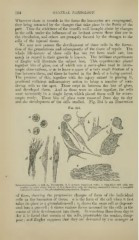Page 694 - My FlipBook
P. 694
704 GENERAL PATHOLOGY.
"Wherever there is trouble in the tissue the leucocytes are congregated,
they being attracted by the changes that take place in the fluids of the
part. Thus the stickiness of the vessel's wall brought about by changes
in the cells under the influence of an irritant arrests those that are in
the circulation, and others are promptly formed by the changes in the
cells of the injured tissue.
We may now pursue the development of these cells in the forma-
tion of the granulations and subsequently of the tissue of repair. The
whole life-history of these cells has not yet been made out, but
much in regard to their growth is known. The brilliant experiments
of Ziegler will illustrate the subject best. This experimenter placed
together bits of glass, one of which was a cover-glass used in micro-
scopic observations, so as to leave a space of a very small fraction of a
line between them, and these he buried in the flesh of a living animal.
The presence of this, together with the injury caused in placing it,
produced sulficient inflammatory action to bring a number of wan-
dering cells to the spot. These crept in between the bits of glass,
and developed there. And as these were so close together, the cells
were necessarily in a single layer, which placed them well for micro-
scopic study. These bits of glass were removed from day to day
and the development of the cells studied. Fig. 394 is an illustration
Granulation-cells: a and Oj, leucocytes; h. h, various formative cells; c, formative cell with two
nuclei; e^, with many nuclei; rf, f/, rf, formative cells developing connective tissue; e, complete
connective tissue (X 500, picrocarmine preparation, Ziegler).
of these, showing the progressive changes of form of the individual
cells in the formation of tissue, a is the form of the cell when it first
takes its place as a granulation-cell ; a, shows the same cell as degener-
ated into a pus-cell ; 6 shows various forms assumed by the cells in the
course of their development into tissue. In watching these from day to
day it is found that certain of the cells, presumably the weaker, disap-
pear ; and Ziegler supposes that they are devoured by the stronger or


